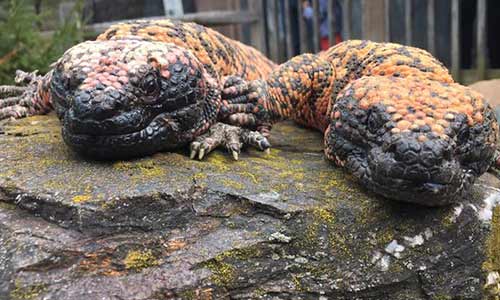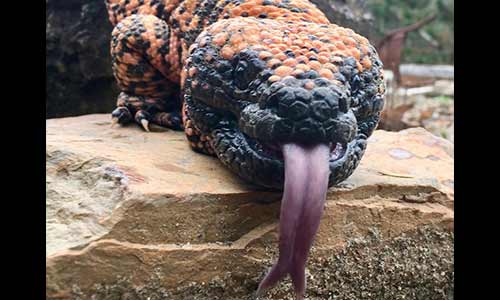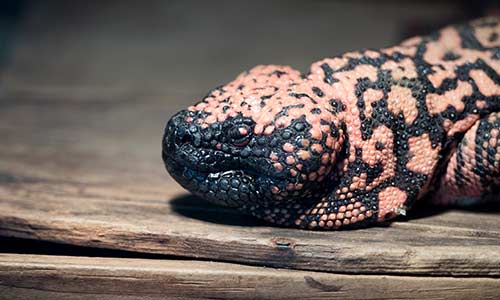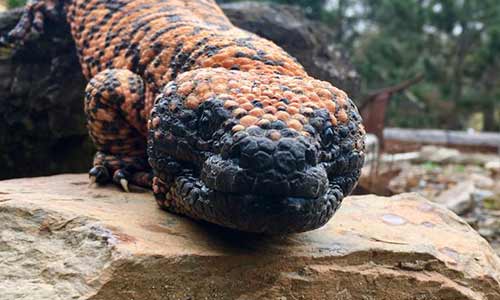Gila Monster
Heloderma suspectum
About the Gila Monster

Geographic Range:
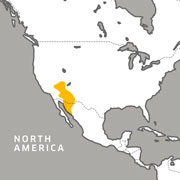
Class: Reptilia
Order: Squamata
Family: Helodermatidae
Genus: Heloderma
Species: suspectum
The Gila monster is the largest lizard native to the United States. They're stout with an elongated body, short limbs, and sharp claws. Their thick, blunt tails are specially adapted to allow the lizards to store fat for future needs. A well-nourished Gila will have a thick, robust tail. Their skin is unique, with individual, round, raised scales that give these lizards a beaded appearance and texture. Small, bony plates are embedded in their scales. Although such protective "bony skin" appears to have been fairly common in dinosaurs, the Gila is one of the few living reptiles with these types of scales.
Committed to Conservation
The main threat to Gila monsters is habitat destruction. Because the species is found in a relatively limited region (parts of southwestern United States and northern Mexico), development can have significant adverse effects, destroying habitat and limiting or blocking connectivity between populations. This species is also threatened by the illegal wildlife trade, as ownership is banned in some states.
You can help!
Responsible pet ownership is a great way to protect wildlife, like Gila monsters. Before bringing home a new pet, ask where the animal came from and if it’s legal to own where you live. Learn more about our work to save animals from illegal trafficking.
Gila Monster Facts
Appearance:
The Gila monster is the largest lizard native to the United States. These lizards are stout with an elongated body, short limbs and sharp claws. These claws are suited to digging burrows and to dig out other animals' eggs for food. Their thick, blunt tails are specially adapted to store fat for future needs, and a well-nourished Gila will have a thick, robust tail. Male and female lizards look very similar and have few differences to help distinguish them. Typically, male Gilas have slightly broader heads and stouter builds, whereas females have narrower heads and pear-shaped bodies.
This lizard’s skin is unique, with individual, round, raised scales that give them a beaded appearance and texture. Small, bony plates are embedded in their scales. Although such protective "bony skin" appears to have been fairly common in dinosaurs, the Gila is one of the few living reptiles with these types of scales.
Gila monsters have evolved to fit in well with their surroundings. Their colorful, beadlike skin camouflages them in the desert. Gila colors and patterns vary throughout their range. Generally, these lizards are pink, yellow or orange with black reticulated and/or banded patterns.
Size:
Length: Up to 22 inches long
Weight: 3 - 5 pounds
Diet:
The Gila monster diet consists of small mammals, lizards, frogs, insects, carrion, birds and eggs. They've adapted to eating large meals infrequently. This allows them to consume most of their food during their limited spring activity period. Gila monsters can consume large quantities of food (up to 1/3 of their body weight) and their resting metabolic rate is so low that the energy expenditure for foraging is offset by their long periods of inactivity.
Reproduction:
Gilas reach sexual maturity at 3 to 5 years of age. Lizards mate in late April to early June when food is most abundant. During their courtship, males will fight for the right to breed with a female. A female Gila can lay between two and 12 eggs at a time. She will incubate them in damp soil for around four to five months. Eggs are usually around 2.5 inches and can weigh around 1.4 ounces. At birth, a baby Gila is around 6.3 inches long. Lizards can take about three to five years to mature and live between 20 - 30 years.
Behavior:
Gila monsters are solitary animals, usually only gathering in a communal area in the spring during their mating season. They spend most of their time hiding in rocky outcroppings, and they’re more active at night. These lizards are slow-moving and sluggish by nature. Gila monsters are not known to vocalize, but they’ll hiss if threatened. They typically use their body language and scent to communicate.
Adult Gilas are predominately diurnal (active during the day). To avoid the extreme heat of the desert, most of their activity occurs in the morning and late afternoon. Sometimes, during the summer, they're seen out after dark, especially in the southern part of their range. Gilas have relatively “leaky” skin, and they avoid dehydration by spending most of their lives in moist and humid shelters. They spend most of their lives underground, hibernating throughout the year and emerging for three months in the spring to feed and mate. They can be seen throughout the year basking at the entrance of their shelters on unseasonably warm, winter days.
A Gila's venom is designed for protection-- not for collecting food. Biting is a last resort. The venom is delivered any time the Gila bites because it's instantaneously injected from the grooves in the teeth of the lower jaw. Often, the lizard will continue to grip and chew additional venom into its victim. The venom contains substances that may cause pain, edema, bleeding, nausea and vomiting in humans, but is seldom fatal.
Habitat/Range:
Gila monsters are found in the southwestern United States, living at elevations to 1,500 meters and seem to prefer semi-arid rocky regions, avoiding open flats and agricultural areas.
Median Life Expectancy:
Approximately 20 years in the wild
Threats:
Gila monsters are threatened by habitat destruction and increasing urbanization as well as the illegal wildlife trade.
Fun Facts:
- Gila monsters are one of many venomous lizards. Their venom is as toxic as a rattlesnake.
- Venom from Gila monsters was used to create a Type 2 Diabetes treatment.
- The first venomous animal to be given legal protection, the Gila monster is protected in all states within its range.
You Can Find This Animal in the Treasures of the Sierra Madre
Guarded Gilas
The first venomous animal to be given legal protection, the Gila monster is protected in all states within its range.
You May Also Like
At Franklin Park Zoo:
At Stone Zoo:

